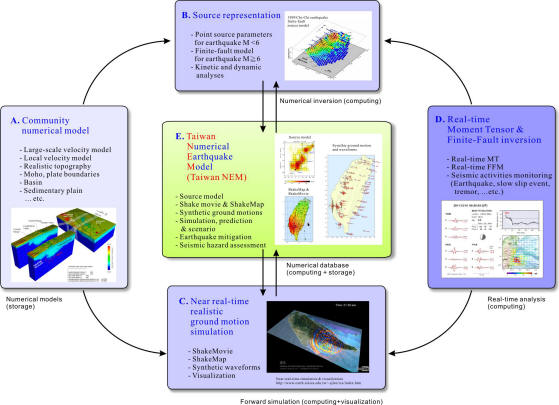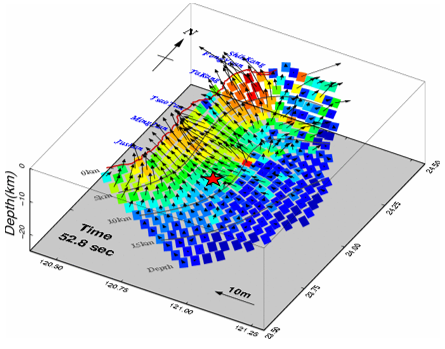Figure1. Framework of Taiwan Numerical Earthquake Model (TNEM).
>> Research
My recent research achievements are twofold: (1) Numerical inversion of precise source rupture model; (2) Forward simulation of high resolution 3-D wave propagation. Based on these research achievements and experiences, I am planning to systematically collect the numerical source inversion models and forward ground motion simulation results to build the Taiwan Numerical Earthquake Model (TNEM). There are five major research topics included in the TNEM (http://tnem.earth.sinica.edu.tw):
C. Realistic ground motion simulation
E. Taiwan Numerical Earthquake Model

Figure1. Framework of Taiwan Numerical Earthquake Model (TNEM).
Numerical simulations have been successfully used to model the complexity of strong ground motions and seismic hazards. However, in the Taiwan region laterally heterogeneous sediments and notable undulation of high mountains pose a considerable numerical challenge. To accommodate the remarkable surface topography as well as the highly variable low wave-speed sedimentary basin, Lee et al. (2008a, 2009) applied the spectral-element method (SEM) to simulate ground motions in the Taipei Metropolitan Area (TMA). These meshing techniques developed are also applied to construct the spectral-element mesh of whole Taiwan now. Figure 2 shows the result of the Taiwan SEM mesh. Although the model looks promised, a few model parameters, such as the depth distribution of Moho discontinuity beneath Taiwan, the exact plate boundaries, and the detail 3-D velocity structure, are not yet well determined. For the purpose of numerical modeling, the first important task is to build up a precise numerical model of the whole Taiwan based on the given geophysical and geologic information.

Figure 2. The spectral-element method mesh model for the whole Taiwan.
Reference:
Lee, S. J., H. W. Chen, Q. Liu, D. Komatitsch, B. S. Huang and J. Tromp (2008a), Three-dimensional simulations of seismic wave propagation in the Taipei basin with realistic topography based upon the spectral-element method, Bull. Seism. Soc. Am., 98, 253-264, doi: 10.1785/0120070033.
Lee, S. J., H. W. Chen and B. S. Huang (2008b), Simulation of Strong Ground Motion and 3-D Amplification Effect in the Taipei Basin by using a Composite Grid Finite-Difference Method, Bull. Seis. Soc. Am., 98, 1229-1242, doi: 10.1785/012/0120060098.
Lee, S. J., Y. C. Chan, Komatitsch, B. S. Huang, and J. Tromp (2009), Effects of realistic surface topography on seismic ground motion in the Yangminshan region (Taiwan) based upon the Spectral-Element Method and LiDAR DTM, Bull. Seis. Soc. Am., 99, 681-693, doi: 10.1785/0120080264.
A precise description of earthquake source is important for the simulation of ground motions. The central moment tensor (CMT) inversion technique is one of the common ways to retrieve earthquake source properties. Lee et al. (2010) developed a grid-based moment tensor inversion technique which can improve the accuracy of earthquake location and obtain a reliable focal mechanism simultaneously. The inversion procedure is based on a database of grid-distributed 3-D Green’s functions which are calculated by SEM.
For larger-sized earthquakes, the source complexity cannot be ignored and a finite source model must be used to describe earthquake rupture. Lee et al. (2006) develop a parallel Non-Negative Least-Squares (Parallel NNLS) inversion technique. Using the Parallel NNLS scheme, the range of inverted parameters covers all spatio-temporal unknowns during the rupture and thus becomes a “full time-space” inversion. More details about this technique and its application to finite-fault inversion for the rupture process of large earthquakes can be found in Lee et al. (2006, 2008, 2011, 2012) and Konstantinou et al. (2009a, 2009b).

Figure 3. The 1999 Chi-Chi earthquake 3D finite-fault source model (2009 updated).
Reference:
Lee, S. J. and K. F. Ma, 2000. Rupture Process of the 1999 Chi-Chi, Taiwan, Earthquake from the Inversion of Teleseismic Data, Terr. Atmos. Oceanic Sci., 11, 591-608.
Lee, S. J., K. F. Ma and H. W. Chen, 2006. Three-dimensional dense strong motion waveform inversion for the rupture process of the 1999 Chi-Chi, Taiwan, earthquake, J. Geophys. Res., 111, B11308, doi:10.1029/2005JB004097.
Lee, S. J., W. T. Liang and B. S. Huang, 2008. Source Mechanisms and Rupture Processes of the 26 December 2006 Pingtung Earthquake Doublet as Determined from the Regional Seismic Records, Terr. Atmos. Oceanic Sci., 19, 555-565, doi: 10.3319/TAO.2008.19.6.555(PT).
Lee, S. J., B. S. Huang, M. Ando, H. C. Chiu and J. H. Wang, 2011. Evidence of large scale repeating slip during the 2011 Tohoku-Oki earthquake, Geophys. Res. Lett., 38, L19306, doi: 10.1029/2011GL049580.
Lee, S. J., 2012. Rupture process of the 2011 Tohoku-Oki earthquake based upon joint source inversion of teleseismic and GPS data, Terr. Atmos. Ocean. Sci., 23, 1-7, doi: 10.3319/TAO.2011.07.11.01(T).
C. Realistic ground motion simulation
Ground motion simulation and prediction is one of the main topics of strong motion and engineering seismology. I focused my efforts on this issue for several years and successfully simulated strong ground motions generated by the large earthquakes in Taiwan, including the 1999 Chi-Chi earthquake (MW 7.6, Lee et al., 2007), 2002 331 Hualien offshore earthquake (Mw 7.0) and 2010 Jiashian earthquake (ML 6.4). The efforts are also in investigating the realistic surface topography effects on the ground motion (Lee et al., 2009a, 2009b). Recently, numerical simulations can basically predict strong ground motions (~1.0 Hz) generated by future earthquakes. My students and I are trying to incorporate the high frequency part of ground motion (> 2 Hz) by applying several approaches now.
I also worked on the issue of seismic hazard assessment for Taipei metropolitan area (TMA). In order to assess the seismic hazard in TMA, the spectral-element method (SEM) was used to simulate the seismic waves when the undulating surface topography and the highly variable low wave-speed sedimentary layers are taken into account (Lee et al., 2008a, 2008b).
Figure 4. 3D numerical simulation of the 20 April 2015 M6.4 southern Ryukyu subduction zone event.
Reference:
Lee, S. J., H. W. Chen and K. F. Ma (2007), Strong Ground Motion Simulation of the 1999 Chi-Chi, Taiwan, Earthquake from a Realistic 3-D Source and Crustal Structure, J. Geophys. Res., 112, B06307, doi: 10.1029/2006JB004615.
Lee, S. J., H. W. Chen, Q. Liu, D. Komatitsch, B. S. Huang and J. Tromp (2008a), Three-dimensional simulations of seismic wave propagation in the Taipei basin with realistic topography based upon the spectral-element method, Bull. Seism. Soc. Am., 98, 253-264, doi: 10.1785/0120070033.
Lee, S. J., H. W. Chen and B. S. Huang (2008b), Simulation of Strong Ground Motion and 3-D Amplification Effect in the Taipei Basin by using a Composite Grid Finite-Difference Method, Bull. Seis. Soc. Am., 98, 1229-1242, doi: 10.1785/012/0120060098.
Lee, S. J., Y. C. Chan, Komatitsch, B. S. Huang, and J. Tromp (2009a), Effects of realistic surface topography on seismic ground motion in the Yangminshan region (Taiwan) based upon the Spectral-Element Method and LiDAR DTM, Bull. Seis. Soc. Am., 99, 681-693, doi: 10.1785/0120080264.
Lee, S. J., D. Komatitsch, B. S. Huang, and J. Tromp (2009b), Effects of topography on seismic wave propagation: An example from northern Taiwan, Bull. Seis. Soc. Am., 99, 314-325, doi: 10.1785/0120080020.
Real-time computational seismology earthquake report (RCS): http://rcs.earth.sinica.edu.tw
Real-time computational seismology is currently possible to
be achieved which needs highly connection between seismic database and high
performance computing. We are developing and testing a real-time moment tensor
monitoring system (RMT) by using continuous BATS records now. The recent results
show that the source parameters, including event time, event location,
magnitude, moment tensor and focal mechanism can be obtain simultaneously within
102 seconds once the earthquake occurred.
Our long-term goals are to apply this technique to: (1) real-time monitoring the
seismic activities for earthquakes M<6; and (2) real-time finite-fault source
inversion for earthquakes M>=6. Once these goals are achieved, the follow-up
near real-time earthquake simulation (ShakeMovie & ShakeMap) can be done
straightforwardly for M>5 earthquakes. These results, including the real-time
source parameters, synthetic seismic wave propagation and ShakeMap , will apply
to reduce the time needed in the seismic hazard assessment (see RCS webpage for
more details).

Figure 5. Earthquake report provided by real-time moment tensor monitoring system.
Reference:
Lee, S. J., B. S. Huang, W. T. Liang, and K. C. Chen (2010), Grid-based moment tensor inversion technique by using 3-D Green’s functions database: A demonstration of the 23 October 2004 Taipei earthquake, Terr. Atmos. Ocean. Sci., 21, 503-514, doi: 10.3319/TAO.2010.01.25.02(TH).
Lee, S. J., W. T. Liang, H. W. Cheng, F. S. Tu, K. F. Ma, H. Tsuruoka, H. Kawakatsu, B. S. Huang and C. C. Liu, 2013. Toward real-time regional earthquake simulation I: Real-time Moment Tensor monitoring (RMT) for regional events in Taiwan, Geophys. J. Int., doi: 10.1093/gji/ggt371.
Lee, S. J., Q. Liu, J. Tromp, D. Komatitsch, W. T. Liang, and B. S. Huang, 2014. Toward real-time regional earthquake simulation II: Real-time Online earthquake Simulation (ROS) of Taiwan earthquakes, Journal of Asian Earth Sciences, http://dx.doi.org/10.1016/j.jseaes.2014.02.009.
Real-time Moment Tensor monitoring system (RMT): http://rmt.earth.sinica.edu.tw
Real-time Online earthquake Simulation (ROS): http://ros.earth.sinica.edu.tw
Real-time Computational Seismology earthquake report (RCS): http://rcs.earth.sinica.edu.tw
E. Taiwan Numerical Earthquake Model
Based on the recent research achievements in each component of the computational seismology framework, I would like to systematically investigate and collect all the numerical source inversion and forward ground motion simulation results to build the Taiwan Numerical Earthquake Model (Taiwan NEM).
For the past big earthquakes occurred in Taiwan, such as the 1999 Chi-Chi earthquake, 2002 Hualien offshore earthquake and 2006 Pingtung earthquake, the finite-fault numerical source model will investigate first using the full time-space inversion approach based on parallel NNLS technique. Then according to the inverted source model and structure model, a 3-D wave propagation simulation will be performed to reconstruct the strong ground motion and 3D wave field time history during the earthquake. For the recent moderate earthquake, the RMT (Real-time Moment Tensor monitoring system) can provide quick information of source parameters, including the event location, time, magnitude and focal mechanism. For the future large earthquake, the RFM (Real-time Finite-fault Monitoring system) will provide first-order information about source rupture, including the rupture direction and focal mechanism changes between subevents. All of these source information can be applied to the ground motion simulation study that can produce the ShakeMovie and ShakeMap in near real time. These numerical techniques and research experiences will apply on the study of scenario earthquake for the future big events that might be occurred in Taiwan.
By collecting all the numerical source models and numerical wave propagation simulation results, a numerical earthquake database of hazardous earthquakes, including the past, recent events and future scenario earthquakes, in Taiwan will establish. The collection of numerical earthquake models can apply not only on the study of earthquake source physics but also on the earthquake engineering. The long-term goal of this research is to realize ground motion prediction as well as to give contribution for earthquake mitigation and seismic hazard assessment.

Figure 6. Example of the Taiwan Numerical Earthquake Model.
Reference:
Lee, S. J., W. T. Liang, L.
Mozziconacci, Y. J. Hsu, W. G. Huang and B. S. Huang, 2013. Source complexity of
the 4 March 2010 Jiashian, Taiwan Earthquake determined by joint inversion of
teleseismic and near field data. Journal of Asian Earth Sciences, 64, 14-26.
Lee, S. J., H. H. Huang, J. Bruce H. Shyu, T. C. Lin and T. Y. Yeh, 2014.
Numerical earthquake model of the 31 October 2013 Ruisui, Taiwan, Earthquake:
Source rupture process and seismic wave propagation, Journal of Asian Earth
Sciences, 96, 374-385, doi:10.1016/j.jseaes. 2014.09.020.
Lee, S. J., T. Y. Yeh, H. H. Huang, and C. H. Lin, 2015. Numerical earthquake
models of the 2013 Nantou, Taiwan, earthquake series: Characteristics of source
rupture processes, strong ground motions and their tectonic implication, Journal
of Asian Earth Sciences (in press)